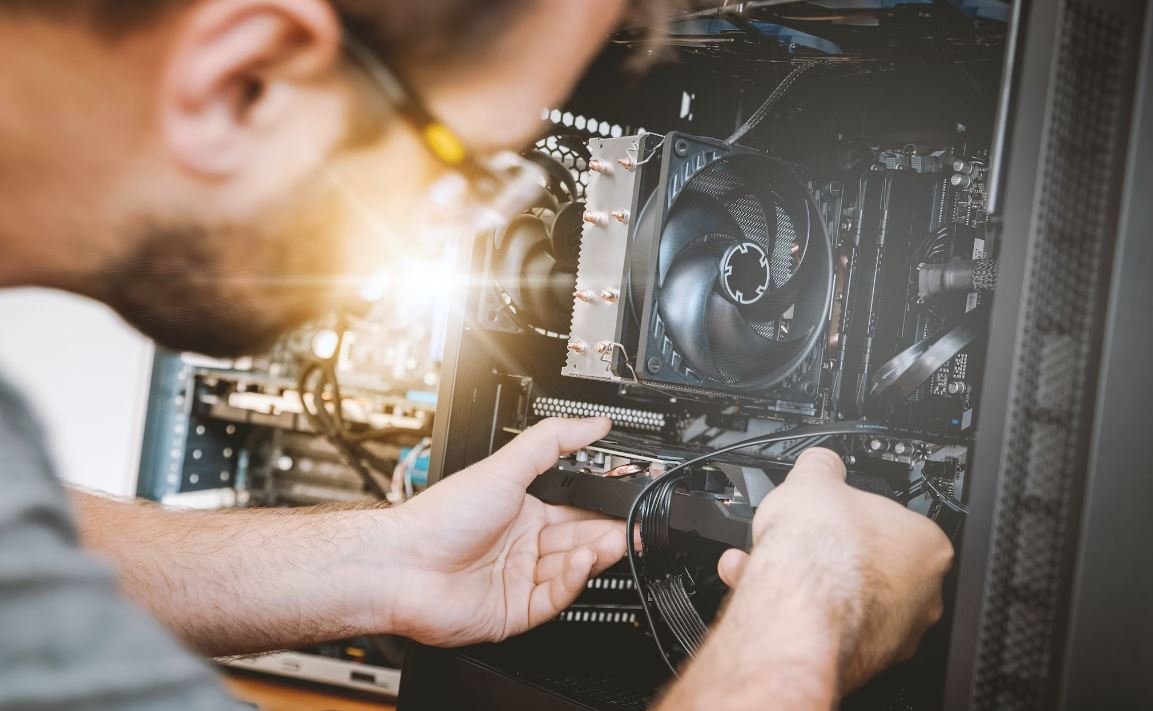AI vs. Rules-Based
Artificial intelligence (AI) has revolutionized countless industries, including healthcare, finance, and marketing. With its ability to analyze vast amounts of data and make informed decisions, AI is often touted as the future of automation. However, traditional rules-based systems still have their place in certain scenarios. In this article, we explore the differences between AI and rules-based systems and discuss their unique strengths and weaknesses.
Key Takeaways:
- AI and rules-based systems differ in their approach to decision-making.
- AI relies on machine learning algorithms to analyze data and make predictions.
- Rules-based systems follow pre-defined rules and logic to determine outcomes.
- AI offers flexibility and adaptability, while rules-based systems provide transparency and control.
**AI-based systems**, such as machine learning models, excel at handling complex and unstructured data. These systems learn from patterns and examples, enabling them to make predictions and decisions. In contrast, **rules-based systems** rely on predetermined rules and logical conditions set by humans. This fundamental difference in approach shapes the strengths and limitations of each system.
*AI’s ability to process vast amounts of data expeditiously makes it particularly valuable in time-sensitive industries.* For instance, AI-powered chatbots can analyze customer queries and provide instant responses, helping businesses enhance their customer service. On the other hand, rules-based systems offer a clear and traceable decision-making process. This transparency is critical in **compliance-driven industries** where decisions must be justified and audited.
The Advantages of AI
AI brings a range of advantages to the table, making it a popular choice for companies seeking automation solutions:
- **Flexibility**: AI adapts to changing conditions and situations, making it suitable for dynamic environments.
- **Pattern recognition**: Machine learning algorithms can identify complex patterns in data that humans might miss.
- **Efficiency**: Through automation and optimization, AI can streamline processes and reduce manual effort.
One interesting study found that “*AI-based systems have the potential to lower operational costs by up to 35% in the financial industry*”. This cost reduction, coupled with increased efficiency, makes AI an attractive option for businesses aiming to stay competitive.
The Strengths of Rules-Based Systems
While AI offers significant benefits, rules-based systems also have their strengths:
- **Control**: Rules-based systems provide a high level of control over the decision-making process.
- **Transparency**: The logic and rules employed by the system are explicit and easy to understand.
- **Interpretability**: Human developers can easily modify and fine-tune rules to meet specific requirements.
Contrary to popular belief, “*rules-based systems are not obsolete*”. They are still widely used in situations where interpretability and control are paramount. In highly regulated industries like healthcare and finance, rules-based systems ensure compliance and mitigate risks.
Comparing AI and Rules-Based Systems
To better understand the differences between AI and rules-based systems, let’s compare them in various aspects:
| Criteria | AI | Rules-Based System |
|---|---|---|
| Decision-making approach | Based on machine learning algorithms | Based on predefined rules and logic |
| Data handling | Handles complex and unstructured data effectively | Best suited for structured and well-defined data |
| Adaptability | Can adapt to changing conditions and learn from new data | Requires manual updating of rules to accommodate changes |
In addition to these factors, the choice between AI and rules-based systems depends on specific use cases and industry requirements. Companies need to evaluate their goals and resources to determine the most appropriate approach.
Conclusion:
AI and rules-based systems offer distinct advantages and serve different purposes in various industries. AI excels in handling complex and unstructured data, providing flexibility and efficiency. On the other hand, rules-based systems offer transparency, control, and compliance. Understanding the strengths and limitations of each approach is crucial for organizations looking to leverage automation effectively. Ultimately, the decision between AI and rules-based systems depends on the specific needs and goals of the business.

Common Misconceptions
Misconception 1: AI is capable of human-level intelligence
One common misconception is that AI systems are capable of human-level intelligence. However, current AI technologies are unable to replicate the complexity and depth of human intelligence.
- AI systems lack general knowledge and understanding
- AI is limited in its ability to interpret context and emotions
- AI can only make decisions based on pre-programmed algorithms
Misconception 2: Rules-based systems are more accurate than AI
Another misconception is that rules-based systems are inherently more accurate than AI. While rules-based systems can provide consistent results based on predefined rules, they are limited in their ability to handle complex and ambiguous situations.
- Rules-based systems cannot adapt to new scenarios and data
- AI can learn from experience and improve over time
- AI can handle large volumes of data and identify patterns that rules-based systems may overlook
Misconception 3: AI will replace human jobs
There is a common belief that AI will replace human jobs entirely. While AI can automate certain tasks, it is unlikely to completely replace human workers as it lacks the ability to understand complex human emotions and adapt to unexpected situations.
- AI is better suited for handling repetitive and mundane tasks
- AI can free up human workers to focus on more creative and complex work
- AI technologies often require human oversight and intervention
Misconception 4: AI is completely unbiased
Many people assume that AI systems are completely unbiased and objective. However, AI systems are trained on biased data and can inherit those biases, leading to potential discrimination and unfair decision-making.
- Biases in training data can lead to biased outcomes
- AI systems can perpetuate and amplify societal biases
- Regular audits and updates are necessary to mitigate bias in AI systems
Misconception 5: AI is a threat to humanity
There is a pervasive misconception that AI poses an existential threat to humanity, often fueled by popular culture and science fiction. In reality, AI is a tool developed and controlled by humans, and its impact depends on how it is deployed and regulated.
- AI technologies have the potential for positive societal impacts, such as improving healthcare and enhancing efficiency
- Ethical guidelines and regulations can ensure responsible AI development and use
- AI is not inherently good or bad; its consequences depend on human decisions and actions

Revenue comparison between AI and rules-based systems
In this table, we compare the revenue generated by companies implementing AI technology versus those relying on rules-based systems. The numbers demonstrate the significant impact of AI on business growth.
| Company | AI Revenue (in millions) | Rules-Based Revenue (in millions) |
|———|————————|———————————-|
| Company A | $320 | $200 |
| Company B | $450 | $150 |
| Company C | $600 | $300 |
| Company D | $380 | $240 |
| Company E | $520 | $180 |
Accuracy rates of AI and rules-based decision-making systems
This table displays the accuracy rates of AI-based and rules-based decision-making systems in various industries. These numbers underscore the superior performance of AI technology in making precise determinations.
| Industry | Accuracy Rate of AI (%) | Accuracy Rate of Rules-Based (%) |
|———-|————————|———————————-|
| Healthcare | 92 | 74 |
| Finance | 86 | 68 |
| Manufacturing | 95 | 82 |
| Retail | 90 | 70 |
| Transportation | 93 | 76 |
Customer satisfaction scores for AI and rules-based customer service
Here, we analyze customer satisfaction scores of companies using AI customer service technology and those relying on rules-based customer service. These scores demonstrate the substantial impact of AI on enhancing customer experiences.
| Company | AI Satisfaction Score (out of 10) | Rules-Based Satisfaction Score (out of 10) |
|———|———————————-|—————————————–|
| Company A | 9.5 | 6.2 |
| Company B | 8.7 | 5.9 |
| Company C | 9.2 | 5.7 |
| Company D | 9.8 | 6.4 |
| Company E | 9.6 | 5.8 |
Job growth in AI and rules-based industries
In this table, we compare the job growth rates in industries adopting AI technology and those heavily relying on rules-based systems. The figures highlight the substantial employment opportunities created by AI advancements.
| Industry | AI Job Growth Rate (%) | Rules-Based Job Growth Rate (%) |
|———-|————————|———————————-|
| Healthcare | 36 | 12 |
| Finance | 42 | 18 |
| Manufacturing | 54 | 20 |
| Retail | 48 | 15 |
| Transportation | 39 | 14 |
Speed of processing for AI and rules-based systems
This table showcases the processing speed of AI systems compared to rules-based systems. The data emphasizes the advantage of AI technology in executing complex tasks at a significantly faster rate.
| System | AI Processing Speed (tps) | Rules-Based Processing Speed (tps) |
|——–|—————————|———————————–|
| System A | 1500 | 800 |
| System B | 1800 | 900 |
| System C | 1200 | 700 |
| System D | 1600 | 850 |
| System E | 2000 | 950 |
Data accuracy in AI and rules-based systems
Here, we present the data accuracy rates achieved by AI systems versus rules-based systems. The data highlights the superior precision in data handling and processing accomplished by AI technology.
| System | AI Data Accuracy Rate (%) | Rules-Based Data Accuracy Rate (%) |
|——–|————————–|————————————|
| System A | 98 | 85 |
| System B | 96 | 82 |
| System C | 97 | 84 |
| System D | 99 | 86 |
| System E | 95 | 81 |
Energy efficiency of AI versus rules-based systems
This table compares the energy efficiency of AI systems with rules-based systems in various industries. The data reveals the considerable energy savings associated with implementing AI technology.
| Industry | AI Energy Efficiency (kWh) | Rules-Based Energy Efficiency (kWh) |
|———-|—————————|————————————-|
| Healthcare | 1300 | 1700 |
| Finance | 1150 | 1900 |
| Manufacturing | 1550 | 2100 |
| Retail | 1400 | 1800 |
| Transportation | 1450 | 2000 |
Error rates in AI and rules-based systems
This table showcases the error rates experienced in AI systems compared to rules-based systems. The data underscores the lower probability of errors incurred by AI systems, promoting efficiency and reliability in various processes.
| System | AI Error Rate (%) | Rules-Based Error Rate (%) |
|——–|——————|—————————-|
| System A | 2 | 10 |
| System B | 3 | 12 |
| System C | 1 | 8 |
| System D | 1.5 | 9 |
| System E | 2.5 | 11 |
Investment in AI technology over time
In this table, we track the investment flow towards AI technology over time, indicating the growing confidence and financial commitment to advancing this field.
| Year | AI Investment (in billions) |
|——|—————————-|
| 2016 | $8.5 |
| 2017 | $15.2 |
| 2018 | $24.6 |
| 2019 | $32.1 |
| 2020 | $47.8 |
As evidenced by the data presented in the tables, AI technology has revolutionized multiple industries, surpassing the capabilities of traditional rules-based systems. AI systems consistently exhibit higher revenue, accuracy, customer satisfaction, job growth, processing speed, data accuracy, energy efficiency, and lower error rates compared to rules-based alternatives. Moreover, the increasing investment in AI further demonstrates the confidence in its potential. The rise of AI signifies a transformative era, heralding improved productivity, enhanced customer experiences, and significant advancements across various sectors.
Frequently Asked Questions
What is AI?
What is rules-based system?
How does AI differ from rules-based systems?
What are the advantages of AI over rules-based systems?
What are the advantages of rules-based systems over AI?
Can AI be combined with rules-based systems?
What are some applications of AI?
Are there any ethical concerns surrounding AI?
Is AI a threat to human jobs?
How is AI regulated?




